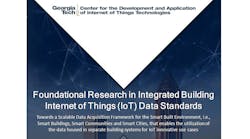The Georgia Institute of Technology’s Center for the Development and Application of Internet of Things Technologies (CDAIT) recently released a research report titled Foundational Research in Integrated Building - Internet of Things (IoT) Data Standards. It investigates what is needed in smart building from an IoT perspective. (CDAIT is a Georgia Tech global, nonprofit, partner-funded center in Atlanta that fosters interdisciplinary research and education, in addition to driving general awareness about IoT’s potential and transformational capabilities.)
“In this report, we propose a strategy and preliminary framework for building-level IoT semantic models and open data strategies,” says Pardis Pishdad-Bozorgi, leader of the team that put the report together and a faculty member of the School of Building Construction. “Semantic models, which, among other things, attach a fundamental and unambiguous description including spatial context to the data and their interconnection, are critical to fostering data interoperability between building systems.”
The report provides a brief review of the National Institute of Standards and Technology’s Cyber-Physical Systems (CPS) and IoT-Enabled Smart City Frameworks, as well as Building Information Modeling (BIM). It also explores how to develop data standards and protocols and puts forth foundational elements for a data acquisition framework for the smart buildings, communities, and cities.
“Buildings often incorporate proprietary networks of sophisticated sensors and actuators in the form of energy and security subsystems and smart home devices,” says Dennis Shelden, director of the Digital Building Laboratory. (DBL is a Georgia Tech research center that pursues technology driven advances in design, construction, and operations for smart buildings.) “Proprietary networks are a tremendous impediment to IoT interconnectivity and innovation. Articulating a sound strategy for connecting emerging IoT data standards with maturing building information standards can fast-track IoT adoption and expansion.”
The research relied on DBL’s years of expertise and experience in developing open building information data exchange standards. DBL faculty and staff are leading members in many international organizations creating BIM data exchange standards.
The targeted audience for this report consists of software and telecom engineers, computer scientists, application developers, IT architects, smart-building architects, system administrators, engineers, architects, business managers, and other parties interested in IoT technical underpinnings.
For a copy of the report, click here and go to the “Related Links”.

